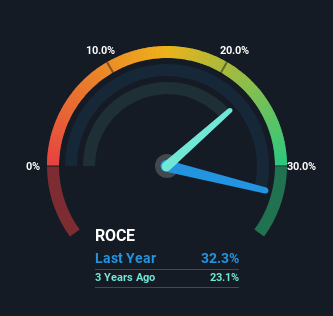- Switzerland
- /
- Marine and Shipping
- /
- SWX:KNIN
A Look Into Kuehne + Nagel International's (VTX:KNIN) Impressive Returns On Capital

What trends should we look for it we want to identify stocks that can multiply in value over the long term? One common approach is to try and find a company with returns on capital employed (ROCE) that are increasing, in conjunction with a growing amount of capital employed. Basically this means that a company has profitable initiatives that it can continue to reinvest in, which is a trait of a compounding machine. Ergo, when we looked at the ROCE trends at Kuehne + Nagel International (VTX:KNIN), we liked what we saw.
Understanding Return On Capital Employed (ROCE)
If you haven't worked with ROCE before, it measures the 'return' (pre-tax profit) a company generates from capital employed in its business. Analysts use this formula to calculate it for Kuehne + Nagel International:
Return on Capital Employed = Earnings Before Interest and Tax (EBIT) ÷ (Total Assets - Current Liabilities)
0.32 = CHF1.9b ÷ (CHF11b - CHF5.2b) (Based on the trailing twelve months to December 2023).
Therefore, Kuehne + Nagel International has an ROCE of 32%. That's a fantastic return and not only that, it outpaces the average of 16% earned by companies in a similar industry.
See our latest analysis for Kuehne + Nagel International

Above you can see how the current ROCE for Kuehne + Nagel International compares to its prior returns on capital, but there's only so much you can tell from the past. If you'd like to see what analysts are forecasting going forward, you should check out our free analyst report for Kuehne + Nagel International .
What Can We Tell From Kuehne + Nagel International's ROCE Trend?
In terms of Kuehne + Nagel International's history of ROCE, it's quite impressive. The company has employed 91% more capital in the last five years, and the returns on that capital have remained stable at 32%. Now considering ROCE is an attractive 32%, this combination is actually pretty appealing because it means the business can consistently put money to work and generate these high returns. You'll see this when looking at well operated businesses or favorable business models.
One more thing to note, even though ROCE has remained relatively flat over the last five years, the reduction in current liabilities to 48% of total assets, is good to see from a business owner's perspective. This can eliminate some of the risks inherent in the operations because the business has less outstanding obligations to their suppliers and or short-term creditors than they did previously. We'd like to see this trend continue though because as it stands today, thats still a pretty high level.
What We Can Learn From Kuehne + Nagel International's ROCE
In summary, we're delighted to see that Kuehne + Nagel International has been compounding returns by reinvesting at consistently high rates of return, as these are common traits of a multi-bagger. And since the stock has risen strongly over the last five years, it appears the market might expect this trend to continue. So while investors seem to be recognizing these promising trends, we still believe the stock deserves further research.
Kuehne + Nagel International does come with some risks though, we found 3 warning signs in our investment analysis, and 1 of those is a bit unpleasant...
If you'd like to see other companies earning high returns, check out our free list of companies earning high returns with solid balance sheets here.
If you're looking to trade Kuehne + Nagel International, open an account with the lowest-cost platform trusted by professionals, Interactive Brokers.
With clients in over 200 countries and territories, and access to 160 markets, IBKR lets you trade stocks, options, futures, forex, bonds and funds from a single integrated account.
Enjoy no hidden fees, no account minimums, and FX conversion rates as low as 0.03%, far better than what most brokers offer.
Sponsored ContentValuation is complex, but we're here to simplify it.
Discover if Kuehne + Nagel International might be undervalued or overvalued with our detailed analysis, featuring fair value estimates, potential risks, dividends, insider trades, and its financial condition.
Access Free AnalysisHave feedback on this article? Concerned about the content? Get in touch with us directly. Alternatively, email editorial-team (at) simplywallst.com.
This article by Simply Wall St is general in nature. We provide commentary based on historical data and analyst forecasts only using an unbiased methodology and our articles are not intended to be financial advice. It does not constitute a recommendation to buy or sell any stock, and does not take account of your objectives, or your financial situation. We aim to bring you long-term focused analysis driven by fundamental data. Note that our analysis may not factor in the latest price-sensitive company announcements or qualitative material. Simply Wall St has no position in any stocks mentioned.
About SWX:KNIN
Kuehne + Nagel International
Provides integrated logistics services in Europe, the Middle East, Africa, the Americas, the Asia-Pacific.
Excellent balance sheet established dividend payer.
Similar Companies
Market Insights
Community Narratives



